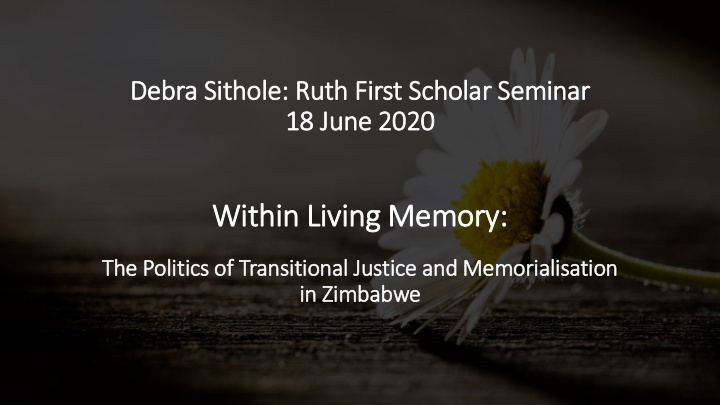



Debra Sit ithole: : Ruth Fir irst Scholar Seminar 18 June 2020 Within Living Memory ry: The Polit litics of Transitional Ju Justice and Memorialisation in in Zim imbabwe
“ Memory is a struggle over power, marked by a struggle of whose memories count ” ( Ycaza and Fox, 2013) • Aims to investigate the recent ‘epistemic turn’ in memory studies; shift from physical sites of memory to digital sites of memory. Analysing how this shift has reframed the memorialisation of Gukurahundi atrocities • Notes how narratives of remembering and existing sites of memory are susceptible to political influence and contestation • Transmission of memories through digital sites of memory, using what I would term cinematic memory (films and documentaries), noting how this approach depoliticises the mnemonic landscape of Gukurahundi.
• Background- The Gukurahundi Massacres and its theories • The role of the State in (mis)shaping the current mnemonic landscape Presentation • Sites of memory thesis: Why the shift from Outline physical to digital sites of memory/cinematic memory? • Are digital spaces sustainable containers of memory? • Conclusion
• Gukurahundi is a Shona term which loosely translates to ‘the early rains that wash away the chaff’. • Gukurahundi became a code-name for the Gukurahundi military operation which plundered Matabeleland and Midlands provinces between and it its theories. 1983-1987. What is is Gukurahundi? • The massacres resulted in the death of over 20,000 civilians, and a thousand more tortured, raped, and mutilated (Ndlovu, 2017). • The hostilities ended in 1987 with the signing of a Unity accord between ZANU and ZAPU parties.
Sch chools of f thought whic ich attempt to ratio ionalise Gukurahundi • It was an act of ethnic cleansing • Quest by the government to establish a one-party state • The product of pre-colonial tribal discourses • Legally sanctioned action, to neutralise threats posed by ZAPU dissidents who threatened the sovereignty of the new state
The role of f the State in in (m (mis)shaping the curr rrent mnemonic la landscape • Role of the state in (mis)shaping the memory of Gukurahundi is best explained by James Scott (1998) in his book Seeing like a State. • Governments engage in extensive social engineering, manipulating social processes, deliberately denying victims and survivors of Gukurahundi closure and justice, while criminalising the remembrance and commemoration of the atrocities (Maedza, 2019). • Political power and influence has become a yardstick which determines who and what is commemorated. • Alexander et al. (1997) argue that the state has repeatedly thwarted Gukurahundi commemorative efforts since the early 1990s through coercion and intimidation using repressive state apparatus.
Ways in in whic ich the state has contested Gukurahundi mnemonic activ ivities • Blocking commemorative marches and vigils
Acts of f iconoclasm/ destroying sites of f memory ry
Criminalisation of f Gukurahundi artistic expressions
Sit ites of f memory ry thesis: : Why the shif ift fr from physical to dig igital sit ites of f memory ry/cinematic memory ry • Physical sites of memory haven’t done justice to the preservation and transmission Gukurahundi memories. • Hence the research challenges Pierre Nora’s (1989 ) ‘Sites of Memory’ thesis which thrives on ‘the visibility of the image ’, i.e. physical containers of memory, geographical spaces, objects and gestures. • Nora’s framework displaces the memory of Gukurahundi. • This research embarks on a search for sustainable media of memory beyond the conventional ‘physical sites of memory ’.
That being said, the research expands Nora’s theory arguing that sites of memory ought to be 3 dimensional to include: physical spaces (geographical, mass graves, plaques) corporeal sites of memory (body as a site of memory) digital sites of memory (documentary films) • It is in line with this thought that ‘cinematic memory’ comes into play, analysing the utility and feasibility of documentary films in preserving, archiving and transmitting memories of the atrocities.
• As a baseline, the research analyses two documentary film productions by a Zimbabwean journalist Zenzele Ndebele to ascertain the effectiveness of cinematic productions/digital sites of memory in the memorialisation of Gukurahundi: (2007) Gukurahundi: A moment of madness- 1982-1987 (2018) Gukurahundi Genocide: 36 years later
Are dig igital spaces sustainable containers of f memory ry? • Documentary films promote the intergenerational transmission of memories, removing traces of official amnesia and silencing • Digital sites of memory allow the subaltern to speak for themselves, giving them a voice allowing them to tell their story in their own way. • Documentary films tend to be investigative, excavating the truth, attaching evidence to memory. • Digital spaces immortalise memory, unlike physical spaces which are subject to destruction and contestation; documentary films preserve discourses of memory in exactly the way they are supposed to be remembered for longer periods of time.
Conclusion • All things considered, although this research is investigative it also aims to facilitate the understanding of this epistemic turn from traditional mnemonic structures, noting that it is not always the case that memories have to be ‘cast in stone’ literally, but rather ought to be flexible enough to conform to the needs of a specific time in history and context. • Hence, now that we exist in the 21 st century, it is conceivable to rally behind the utilisation of digital mnemonic sites in dealing with legacies of state-sanctioned violence.
The end……
Recommend
More recommend